Best JavaScript Unit Testing Frameworks for Web Development

Supercharge Your JavaScript: A Deep Dive into Unit Testing Frameworks
Building reliable JavaScript applications requires thorough testing. Unit testing, in particular, is crucial for verifying individual components function correctly. This listicle explores the top 12 JavaScript unit testing frameworks, providing practical insights into their strengths, weaknesses, and ideal use cases. We'll cover popular choices like Jest, Mocha, and Jasmine, as well as other powerful options like Cypress, Playwright, and Vitest.
This detailed guide goes beyond simple feature lists. You'll gain insights from real-world usage, understand practical implementation considerations, and learn which framework best suits your specific JavaScript development needs. Discover how these JavaScript unit testing frameworks can improve your code quality, reduce bugs, and streamline your development process. Whether you're building a complex web application or a simple script, the right testing framework is essential. Let's dive in and explore the world of JavaScript unit testing.
1. Jest
Jest stands out among JavaScript unit testing frameworks, especially for React projects, thanks to its developer-friendly features and zero-configuration setup. This ease of use doesn't sacrifice power: Jest provides robust tools like snapshot testing, mocking, and parallel execution, simplifying the testing process for projects of all sizes. Its speed, stemming from parallelization and efficient caching, keeps feedback loops short, a boon for any development workflow.
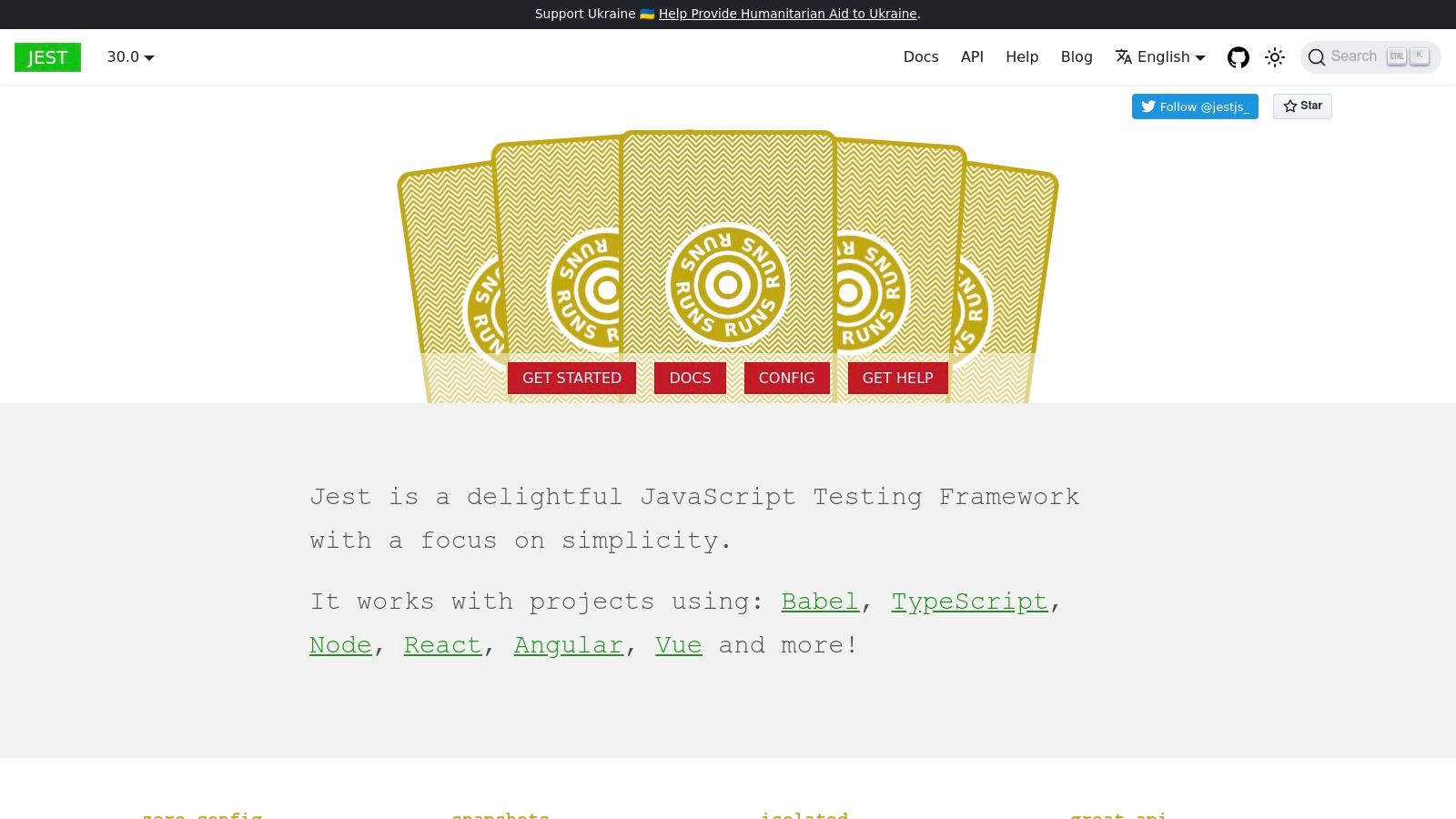
While Jest shines in larger projects, it's worth noting that its comprehensive features might feel excessive for smaller codebases. For instance, the automatic mocking, while helpful for complex interactions, can be cumbersome if you only need a few simple mocks. Similarly, its snapshot testing, while useful for tracking UI changes, can sometimes lead to large snapshot files that become difficult to manage without careful attention. Considering these aspects is crucial when choosing a framework. Learn more about Jest and other web development best practices
Jest is open-source and actively maintained by Facebook, ensuring its continuous improvement and a large community for support. This active community translates into readily available resources, tutorials, and quick solutions to common issues. If you’re looking for a comprehensive and performant JavaScript unit testing framework, particularly within a React ecosystem, Jest deserves serious consideration.
2. Mocha
Mocha offers a flexible and feature-rich JavaScript unit testing framework running on Node.js. Suitable for both backend and frontend testing, Mocha allows developers to tailor their testing environment by using any assertion library, like Chai. This flexibility makes it a popular choice among JavaScript developers who appreciate control and customization in their testing setup. Its adaptability shines when integrating with various project structures and coding styles.
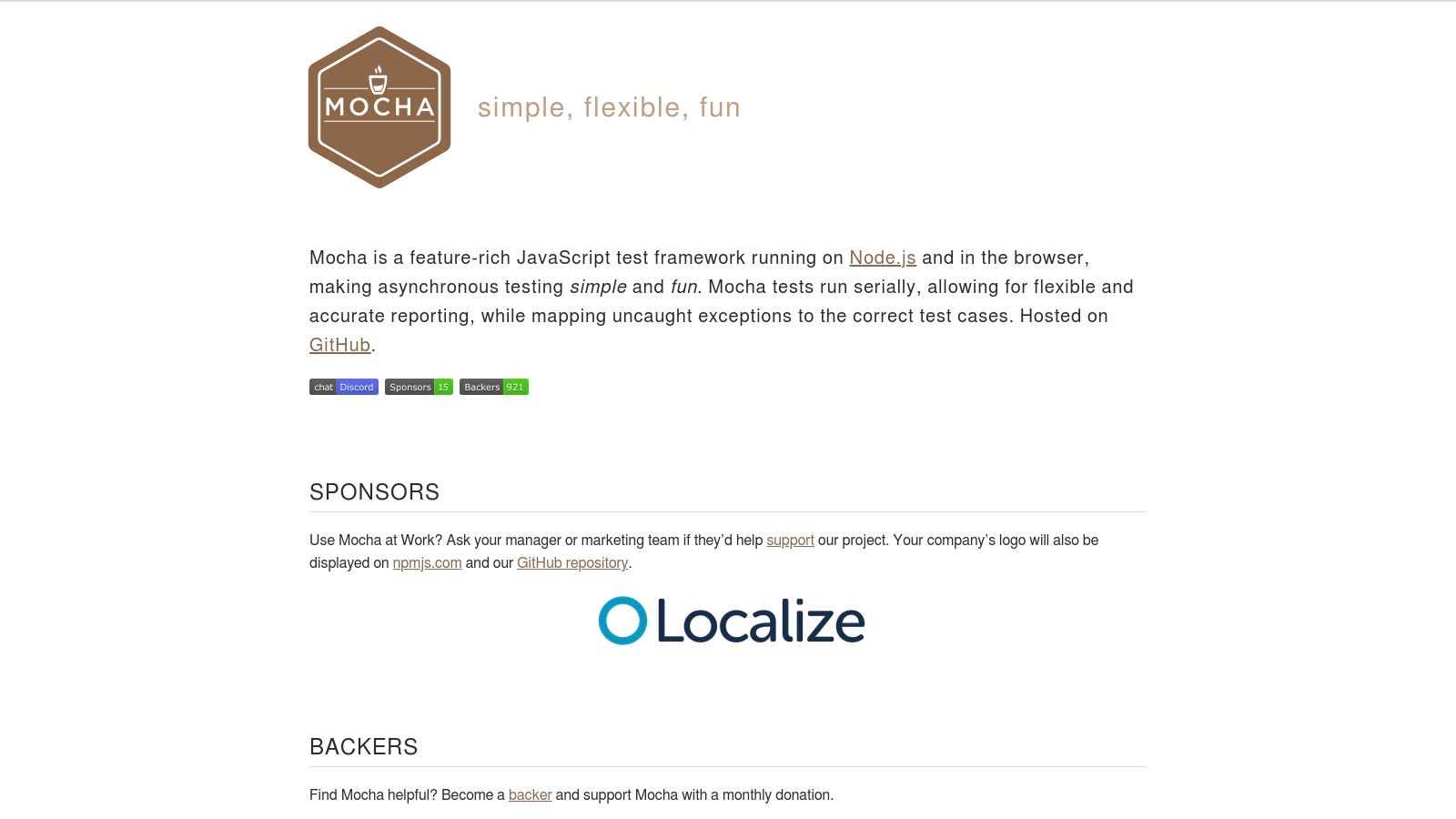
While Mocha's flexibility is a strength, it can also be a hurdle. The need to choose and configure assertion and mocking libraries adds complexity to the initial setup. This can be time-consuming compared to frameworks like Jest, which offer these features out-of-the-box. However, this initial investment allows for a finely-tuned testing environment tailored to specific project needs. Developers experienced with JavaScript testing will likely appreciate this granularity.
Mocha's support for both synchronous and asynchronous testing is essential for modern JavaScript development. This, combined with a rich plugin ecosystem and extensive documentation, makes Mocha a powerful tool for projects of any size. The large and active community surrounding Mocha provides readily available resources and support, ensuring that developers can find solutions to common issues quickly. If you’re looking for a highly customizable and flexible JavaScript unit testing framework, and you're comfortable with a slightly more involved setup, Mocha is an excellent choice. It’s a robust framework that empowers developers to build comprehensive and reliable test suites.
3. Jasmine
Jasmine distinguishes itself among javascript unit testing frameworks with its focus on behavior-driven development (BDD). This approach encourages describing test cases in a human-readable format, enhancing collaboration between developers and stakeholders. Its clean syntax, coupled with built-in assertion libraries, creates a comprehensive solution suitable for both frontend and backend JavaScript testing. Jasmine's out-of-the-box functionality simplifies setup and gets you testing quickly.

While Jasmine's simplicity is a strength, it can also be a limiting factor. Compared to more flexible frameworks like Mocha, Jasmine's smaller plugin ecosystem may restrict customization. This can become noticeable when integrating with certain tools or needing specific reporting capabilities. Furthermore, while Jasmine supports asynchronous testing, handling complex asynchronous scenarios might require more boilerplate code compared to other frameworks.
Jasmine's ease of use makes it a strong contender for projects prioritizing rapid setup and BDD. Its built-in spies facilitate mocking and stubbing, and its support for running tests both in browsers and Node.js adds to its versatility. However, if extensive customization or a large plugin ecosystem is essential, exploring alternative javascript unit testing frameworks like Mocha might be more appropriate. Jasmine is open-source and available at https://jasmine.github.io/.
4. Karma
Karma, developed by the AngularJS team, distinguishes itself as a robust test runner for JavaScript, enabling execution in real browsers. Unlike frameworks offering simulated browser environments, Karma prioritizes real-world testing. This approach ensures your code functions flawlessly across various browsers and devices, minimizing cross-browser compatibility issues. It pairs seamlessly with other JavaScript unit testing frameworks like Jasmine or Mocha, leveraging their assertion libraries while providing the crucial browser execution layer.
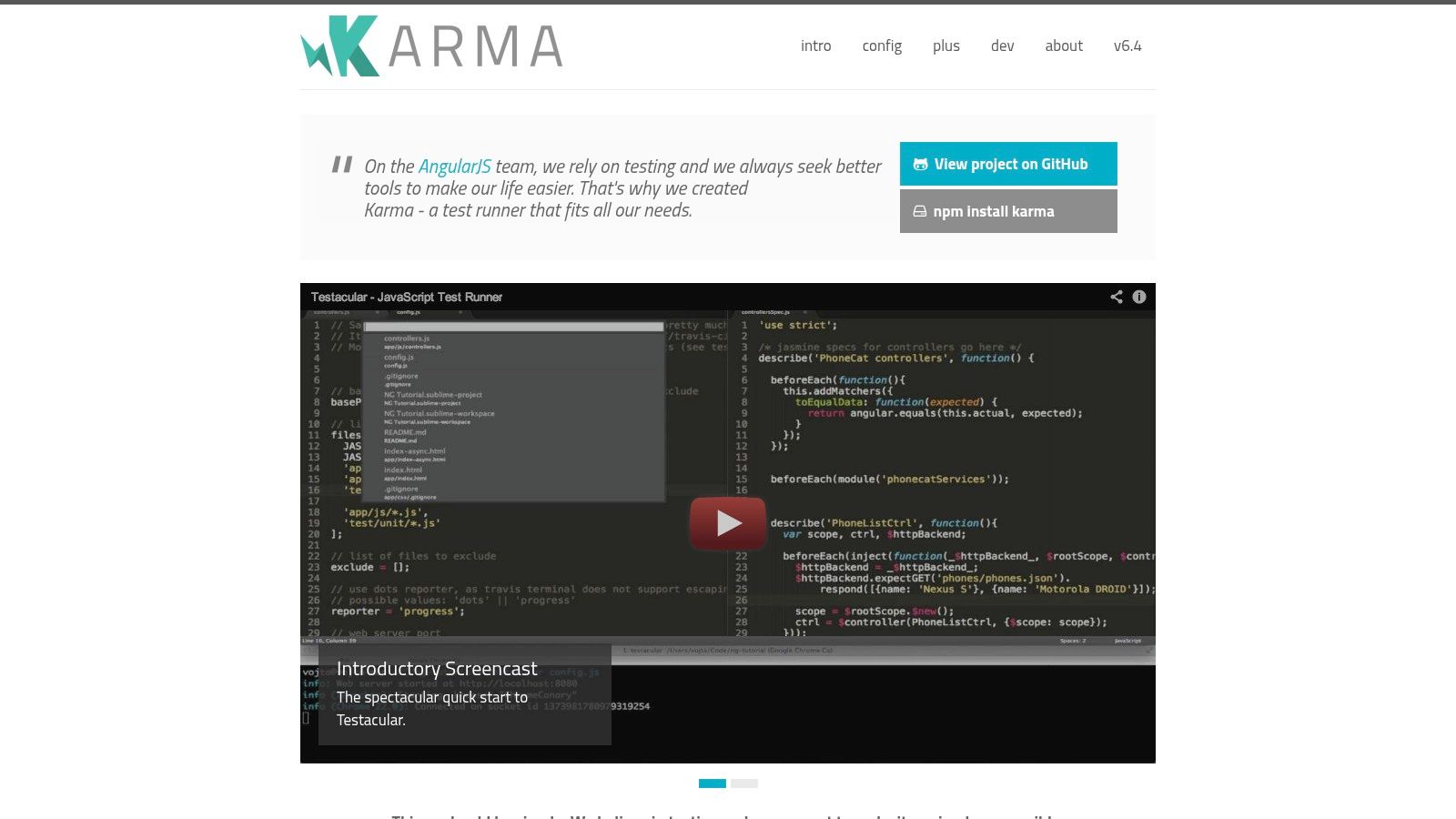
While Karma's real-browser testing offers significant advantages, it comes with a trade-off: speed. Running tests across multiple browsers inherently takes longer than in simulated environments. The setup and configuration can also be more involved, requiring careful consideration of browser launchers and specific configurations. For smaller projects with limited cross-browser concerns, the overhead might outweigh the benefits. However, for larger projects, especially those targeting multiple browsers or devices, Karma's real-world testing capabilities are indispensable.
Karma’s framework-agnostic nature makes it a versatile choice. Its support for continuous integration further enhances its value in professional workflows. Combined with a rich plugin ecosystem accommodating diverse frameworks and preprocessors, Karma offers a highly adaptable and configurable testing environment. This flexibility and robust real-browser testing make Karma a compelling option for projects prioritizing cross-browser compatibility and a robust continuous integration pipeline. Learn more about Karma and other web development best practices
5. Cypress
Cypress is a modern JavaScript-based end-to-end testing framework designed for fast, easy, and reliable testing of web applications directly in the browser. Its standout feature is the real-time reloading and time-travel debugging capabilities, allowing developers to see changes reflected instantly and step through test execution to pinpoint issues. Built-in support for spies, stubs, and clocks simplifies mocking and controlling the test environment. Cypress also automatically waits for commands and assertions, reducing the need for explicit waits and making tests more robust.
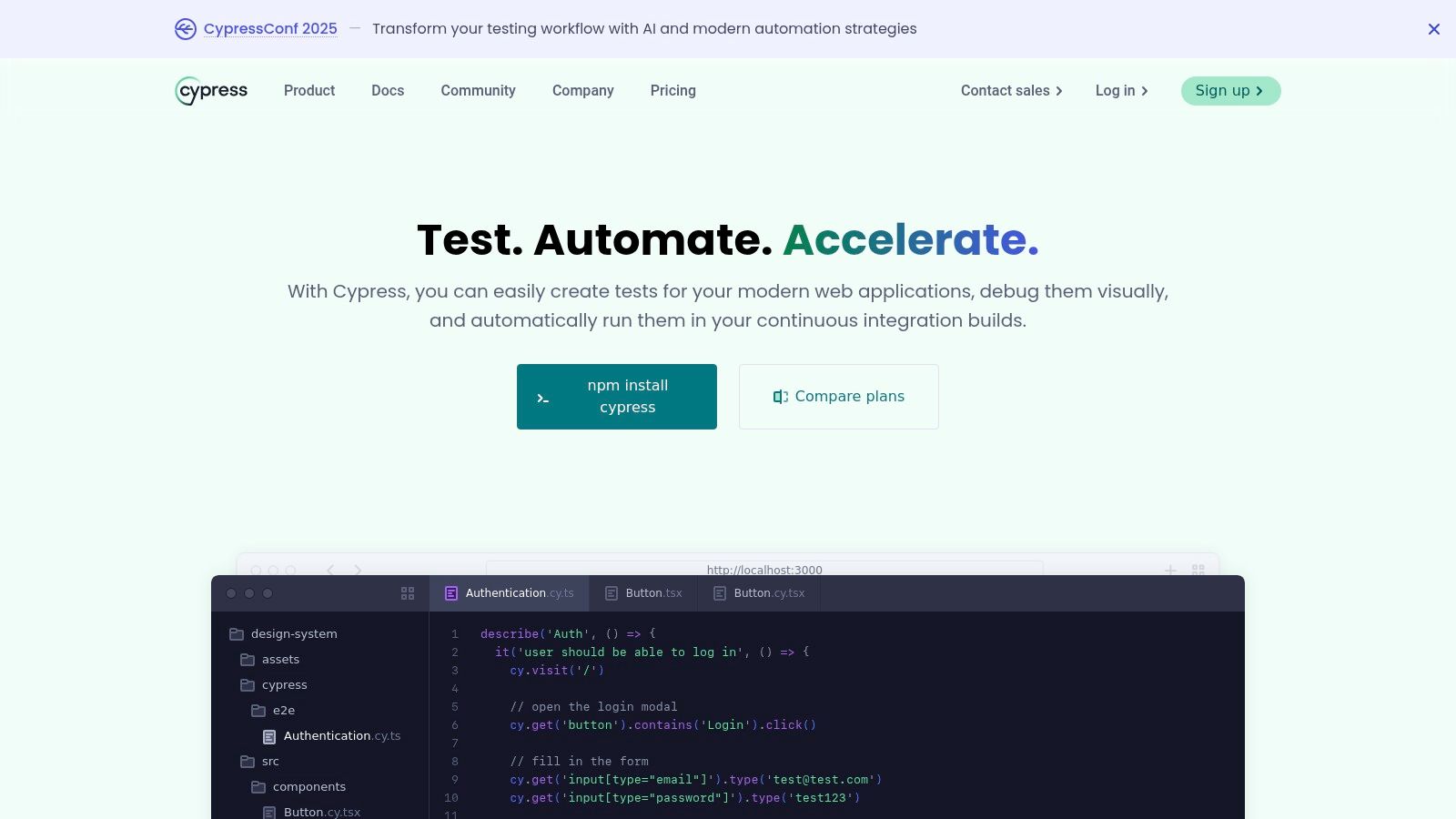
While Cypress excels in providing a smooth and intuitive testing experience, it has certain limitations. It primarily supports Chrome-based browsers, restricting cross-browser testing capabilities. Multi-tab or multi-window testing is also not supported, which can be a drawback for applications requiring such interactions. Understanding these limitations is crucial when considering Cypress for your javascript unit testing frameworks needs. Learn more about Cypress and web application security best practices
Cypress simplifies setup with minimal dependencies and offers comprehensive documentation along with an active community. This readily available support contributes to faster onboarding and quicker resolution of challenges. Its focus on real-time feedback through fast test execution is a significant advantage for developers seeking rapid iteration. If you prioritize a streamlined, browser-centric approach to end-to-end testing, Cypress is a compelling option among javascript unit testing frameworks.
6. Playwright
Playwright excels as a JavaScript unit testing framework, particularly for end-to-end testing. Its comprehensive browser support, covering Chromium, Firefox, and WebKit, allows developers to ensure consistent behavior across different platforms. This cross-browser compatibility is a major advantage when building web applications that need to function seamlessly for all users. Playwright's rich API further simplifies the testing process, providing powerful tools for browser automation, network interception, and mocking.

While Playwright offers robust features, its relative newness compared to other JavaScript unit testing frameworks can present a steeper learning curve for some developers. The active development and growing community, however, mitigate this by providing ample resources and support. Less extensive third-party integrations might also be a consideration for teams reliant on specific tools. Careful evaluation of these aspects is important when integrating Playwright into existing workflows.
Playwright, being open-source and backed by Microsoft, benefits from continuous improvements and a rapidly expanding community. This active development ensures that Playwright stays up-to-date with the latest browser technologies and addresses evolving testing needs. For developers seeking a comprehensive and powerful framework for end-to-end testing, especially across multiple browsers, Playwright is a compelling choice. Its robust API and active community make it a valuable addition to the JavaScript unit testing landscape.
7. Vitest
Vitest shines as a blazing-fast JavaScript unit testing framework built upon Vite. Designed with speed and simplicity in mind, it boasts native ESM support and embraces modern JavaScript features. This makes it an excellent choice for developers working with Vite projects or those seeking a streamlined, modern testing experience. Its performance gains, due to its clever optimization and multi-threaded test runner, significantly reduce feedback loops. This rapid feedback contributes to a more efficient and satisfying development process.

While Vitest excels in speed and modern JavaScript compatibility, it's important to consider its relative youth in the testing landscape. As a newer framework, its community support, though rapidly growing, isn't as extensive as that of more established frameworks. This might lead to fewer readily available resources or slightly less mature tooling in certain niche scenarios. For projects not already using Vite, some additional configuration may be required for seamless integration, potentially offsetting some of its initial setup simplicity. Learn more about Vitest and other factors influencing web application scalability.
Vitest, however, benefits from being open-source and actively developed. This ensures continuous improvements and expanding community involvement. If you are building with Vite, or prioritize a fast, modern testing experience utilizing native ESM and the latest JavaScript features, Vitest is definitely a javascript unit testing framework worth exploring.
8. AVA
AVA shines as a minimalist JavaScript unit testing framework specifically designed for Node.js. Its focus on simplicity and speed, achieved through concurrent test execution, makes it highly effective for managing even extensive test suites. This concurrency, isolating each test in its own process, ensures reliable results and prevents test interference, crucial for complex projects. AVA's clean API further enhances its ease of use, allowing developers to write tests quickly and efficiently.

While AVA excels in speed and simplicity, its minimalist approach also means it lacks some features found in other frameworks. For instance, there's no built-in support for mocking or spying, requiring developers to rely on external libraries. This can introduce additional complexity, especially for projects heavily reliant on mocking. Additionally, its relatively smaller community, compared to Jest or Mocha, might mean fewer readily available resources and solutions to niche issues.
AVA's streamlined nature makes it ideal for projects prioritizing speed and a clean testing environment. Its concise API and concurrent execution significantly reduce testing time, promoting rapid feedback during development. If your Node.js project values a minimalist approach and you’re comfortable managing dependencies for mocking, AVA is a powerful choice for your JavaScript unit testing framework. It's particularly well-suited for testing backend logic and API endpoints where its concurrency can truly shine.
9. QUnit
QUnit, developed by the jQuery team, provides a straightforward and powerful framework for JavaScript unit testing. It's particularly well-suited for testing jQuery-based projects, but its capabilities extend to general JavaScript testing as well. QUnit excels in its simplicity, allowing developers to write tests quickly and efficiently. This ease of use makes it a great choice for projects ranging from small scripts to large web applications.
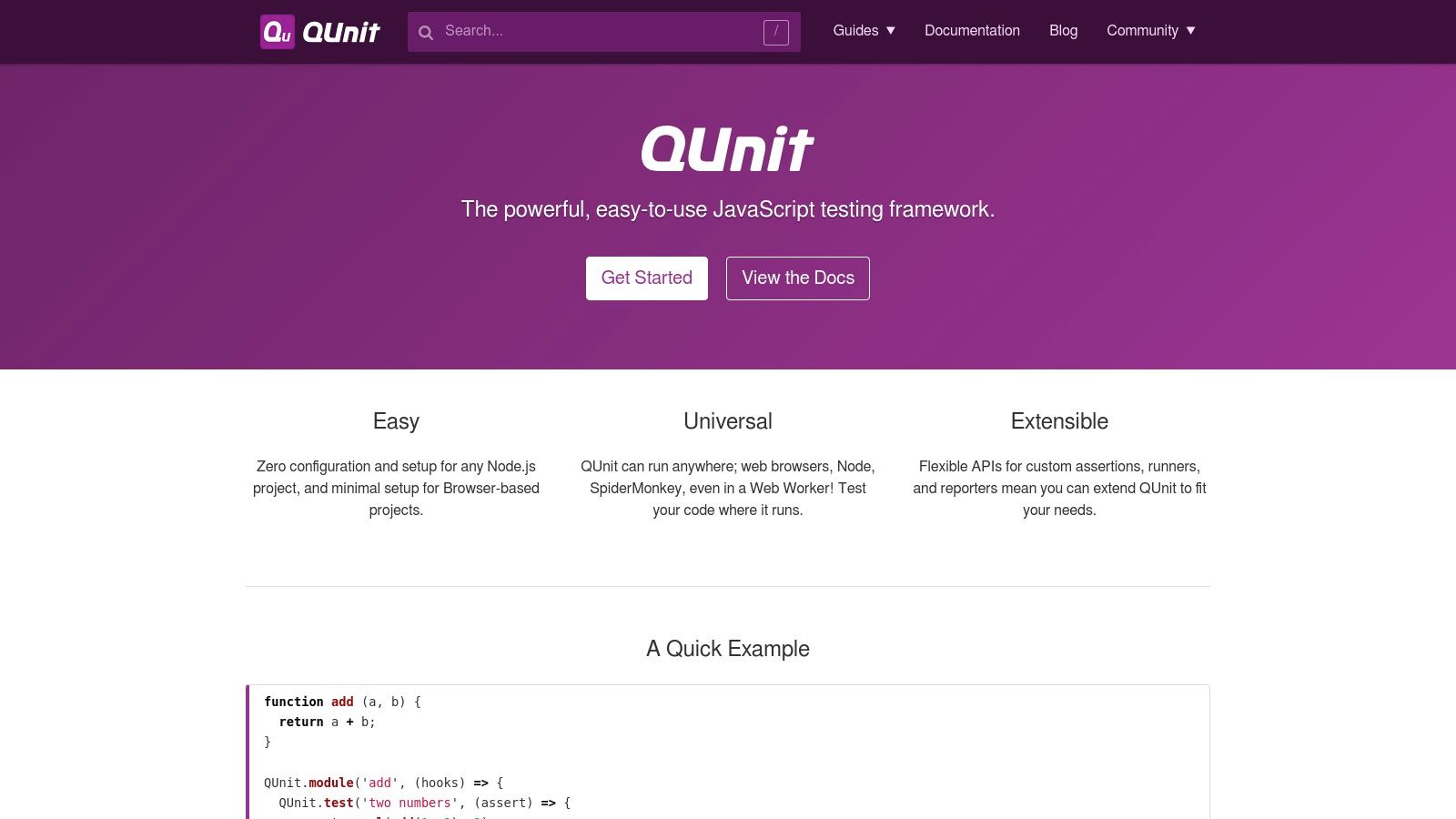
While QUnit's simplicity is a strength, it can also be a limitation when compared to more modern JavaScript unit testing frameworks like Jest or Mocha. QUnit's feature set, while comprehensive for basic testing needs, lacks some of the advanced features found in newer frameworks, such as sophisticated mocking capabilities or built-in support for snapshot testing. If your project heavily relies on jQuery, QUnit's tight integration makes it a natural fit. However, for projects utilizing other libraries or frameworks, exploring alternative solutions might provide a better long-term fit.
QUnit's strong documentation and active community provide ample support for developers. The clear and concise API makes it easy to get started, and the readily available resources ensure quick solutions to common issues. QUnit's support for both browser and Node.js environments adds to its flexibility, allowing developers to test their code in various contexts. If you're looking for a simple, well-documented, and reliable JavaScript unit testing framework, particularly for jQuery-based projects, QUnit remains a solid choice.
10. Sinon.JS
Sinon.JS excels as a standalone JavaScript library specifically designed for creating spies, stubs, and mocks. Its framework-agnostic nature makes it a versatile tool, seamlessly integrating with any JavaScript unit testing framework. This flexibility proves particularly valuable when testing functions heavily reliant on external dependencies, allowing for precise control over their behavior during tests. Sinon.JS empowers developers to isolate the unit under test, ensuring accurate and reliable results.
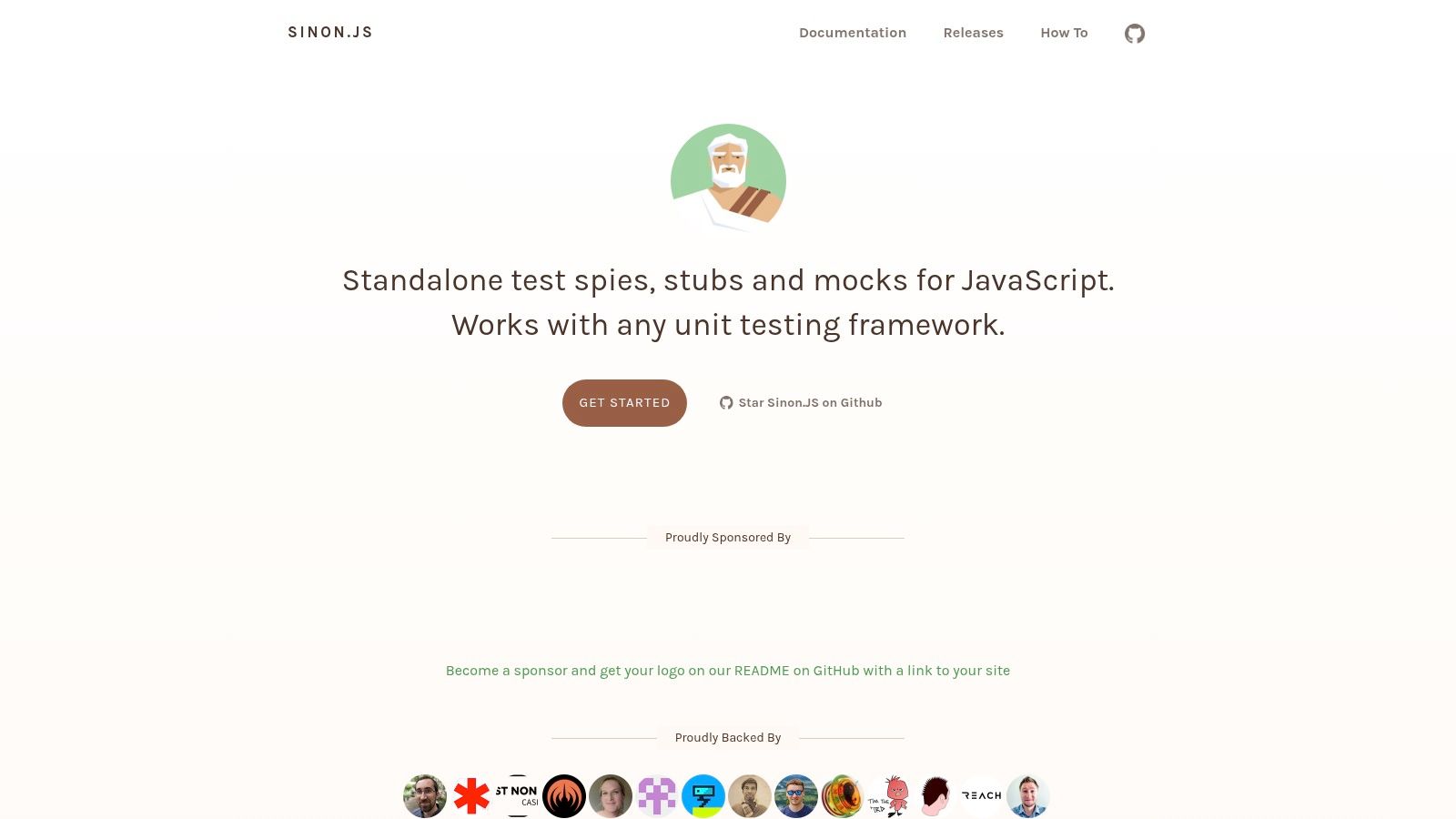
While Sinon.JS boasts a comprehensive suite of features for manipulating function behavior, its standalone nature necessitates integration with a separate testing framework for a complete testing solution. This integration adds a layer of complexity, especially for developers new to testing or Sinon.JS itself. Furthermore, mastering its extensive API for complex scenarios can involve a learning curve. However, the robust documentation and strong community support significantly mitigate this challenge.
Sinon.JS's ability to fake timers is invaluable for testing time-dependent code, providing granular control over time flow within tests. This feature simplifies testing asynchronous operations and timeouts, ensuring predictable and reproducible test results. Its framework-agnostic nature allows developers to leverage Sinon.JS's powerful mocking capabilities within their preferred testing environment, making it a versatile and valuable addition to any JavaScript testing toolkit. If you need fine-grained control over function behavior and dependencies in your JavaScript unit testing workflow, Sinon.JS is a strong contender.
11. Chai
Chai stands out among javascript unit testing frameworks as a versatile assertion library. It seamlessly integrates with any JavaScript testing framework, including Mocha and Jest, offering developers flexibility in their testing setup. Its strength lies in its rich and expressive BDD/TDD assertion styles, making tests more readable and maintainable. This readability enhances collaboration and simplifies debugging, crucial aspects of any successful project.

While Chai's flexibility is a boon, it does require pairing with a separate test runner. This isn't inherently a disadvantage, but it adds a step to the setup process compared to all-in-one solutions like Jest. Also, while its extensive plugin ecosystem provides added functionality, ensuring compatibility across all plugins can occasionally be a challenge. Developers should carefully consider these factors when incorporating Chai into their workflow.
Chai’s expressive syntax, like expect(x).to.equal(y), enhances the clarity of test cases. This is especially valuable in larger projects where multiple developers contribute to the codebase. Its compatibility with both Node.js and browsers extends its usability across various JavaScript development environments. The active community surrounding Chai provides ample resources and readily available solutions, simplifying the integration and troubleshooting process. If you value expressiveness and flexibility in your assertions, Chai is a valuable addition to your JavaScript unit testing toolkit.
12. Puppeteer
Puppeteer, a Node.js library developed by Google, provides a high-level API for controlling headless Chrome or Chromium browsers. While often used for browser automation like web scraping or generating screenshots, Puppeteer also shines as a powerful tool within JavaScript unit testing frameworks, particularly for integration or end-to-end testing. Its ability to simulate real user interactions within a browser environment allows for comprehensive testing of complex web applications.
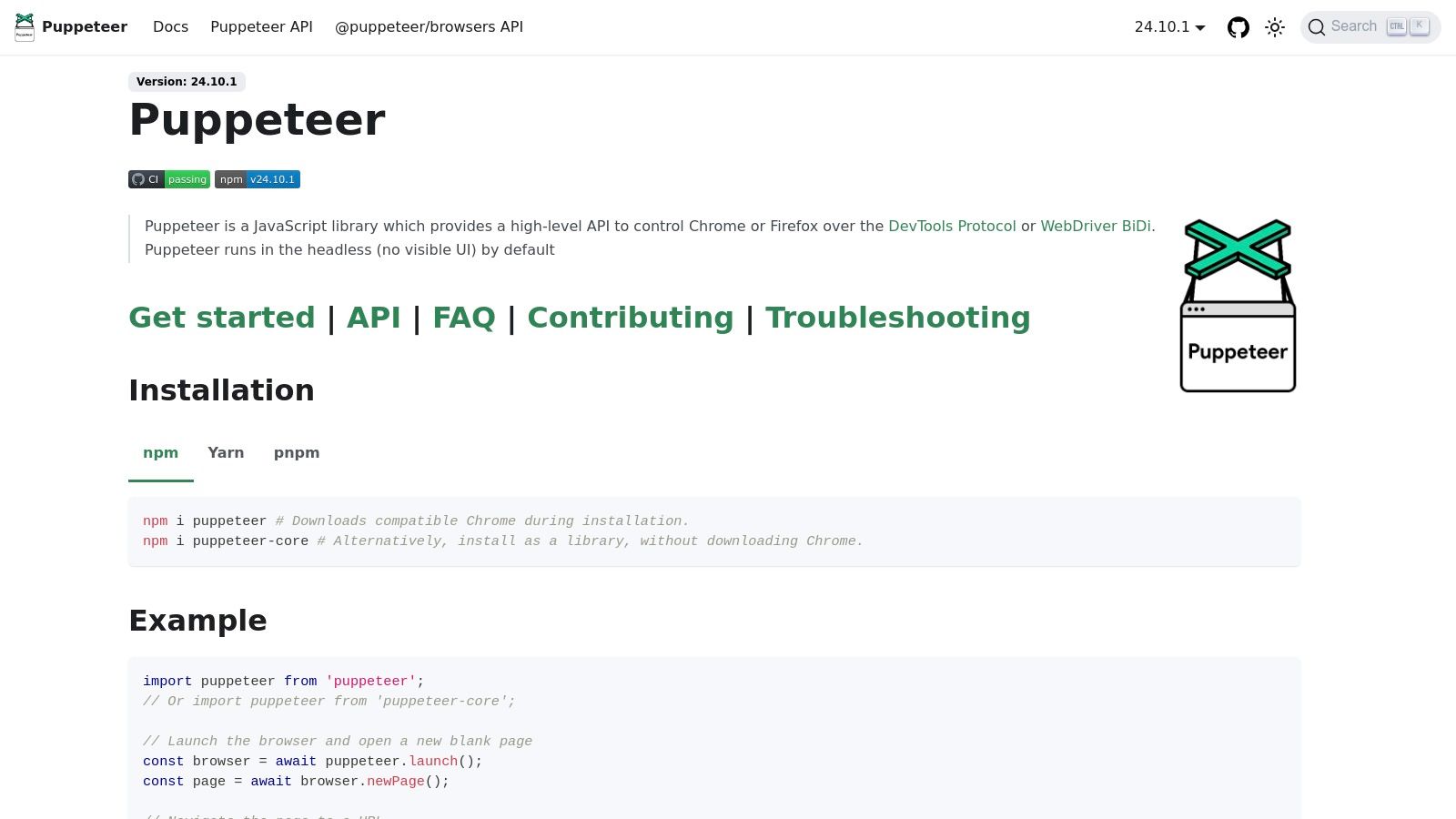
While Puppeteer excels at simulating user interactions, it’s important to acknowledge that it might add complexity to simpler unit tests. If you’re testing individual functions or components in isolation, lighter-weight unit testing frameworks might suffice. Puppeteer’s strength lies in testing the interplay of different components within a full browser context. Setting up and managing a browser instance for each test can also introduce overhead, although Puppeteer’s API makes this relatively straightforward. Choosing Puppeteer depends on the specific needs of your testing strategy.
Puppeteer, being actively maintained by Google, benefits from continuous improvement and a strong community. This ensures access to updated documentation, readily available solutions, and a future-proof approach to web application testing. This support makes Puppeteer an attractive choice for developers seeking a robust and reliable solution for testing complex web interactions. If you're focused on verifying the functionality of your application in a real browser environment, Puppeteer provides a compelling toolkit.
JavaScript Unit Testing Frameworks Comparison
| Framework | Core Features & Highlights ✨ | User Experience & Quality ★★★★☆ | Unique Selling Points 🏆 | Target Audience 👥 | Price Point 💰 |
|---|---|---|---|---|---|
| Jest | Zero-config, snapshot testing, parallel exec | Fast, well-documented, strong community | Seamless React integration, automatic mocking | React devs, JS projects | Free (Open-source) |
| Mocha | Sync/async tests, custom reporting, plugins | Flexible, strong async support | Highly customizable, runs in browser & Node | Backend & frontend JS devs | Free (Open-source) |
| Jasmine | BDD style, built-in spies, no dependencies | Easy setup, all-in-one features | Supports BDD & TDD, runs in browsers/Node | Frontend & backend JS devs | Free (Open-source) |
| Karma | Real browser tests, CI support, framework agnostic | Reliable cross-browser testing | Real-time feedback, CI friendly | Teams needing cross-browser tests | Free (Open-source) |
| Cypress | Time-travel debugging, screenshots, network control | Fast, real-time reloads, easy setup | End-to-end testing with video capture | Web app devs, frontend testers | Free (Open-source) |
| Playwright | Multi-browser support, cross-language, network mocks | Rich automation API, active community | Chromium, Firefox & WebKit support | Cross-browser E2E testers | Free (Open-source) |
| Vitest | Native ESM, multi-threaded, TypeScript support | Fast execution, simple integration | Optimized for Vite, modern JS features | Vite users, modern JS devs | Free (Open-source) |
| AVA | Concurrent tests, minimal API, async support | Speedy with clean syntax | Emphasizes atomic tests | Node.js devs, minimalist testers | Free (Open-source) |
| QUnit | Sync/async tests, strong assertion methods | Simple API, readable reports | Strong jQuery integration | jQuery projects, general JS devs | Free (Open-source) |
| Sinon.js | Standalone mocks/spies, async support, timers | Flexible, comprehensive API | Framework agnostic function manipulation | All JS testers needing mocks | Free (Open-source) |
| Chai | BDD/TDD assertions, extensible plugins | Expressive syntax, easy integration | Rich assertion styles for better readability | Developers paired with test runners | Free (Open-source) |
| Puppeteer | Headless automation, screenshots, device emulation | Powerful browser control | Maintained by Google, Chromium focused | Browser automation, E2E testers | Free (Open-source) |
Level Up Your Testing: Choosing the Right Framework
Selecting the perfect JavaScript unit testing framework from the wealth of options available can feel overwhelming. This article explored twelve popular frameworks, each with its own strengths and weaknesses. From Jest's all-in-one approach to Mocha's flexibility and Jasmine's behavior-driven development style, there's a framework suited to every project. Remember, the "best" framework isn't universal; it's the one that best aligns with your specific needs.
Key Takeaways and Considerations
Let's recap some crucial points to consider when choosing a JavaScript unit testing framework:
Project Size and Complexity: For smaller projects, a simpler framework like AVA or QUnit might suffice. Larger, more complex applications may benefit from the robust features of Jest, Cypress, or Playwright.
Team Familiarity: If your team already has expertise in a particular framework, the learning curve and onboarding will be significantly smoother.
Integration with Existing Tools: Consider how well the framework integrates with your current development environment and other tools in your workflow.
Community Support and Documentation: A strong community and comprehensive documentation are invaluable when troubleshooting issues or seeking guidance.
Specific Testing Needs: Do you require end-to-end testing capabilities? Frameworks like Cypress and Playwright excel in this area. Are you focused on browser compatibility? Karma might be a good fit.
Making Your Decision
Choosing a framework involves carefully evaluating these factors in the context of your project. Don't be afraid to experiment with a few different options to see which one feels the most natural and productive for your team. Start by identifying your must-have features, then explore frameworks that offer those capabilities. Examine the documentation and community forums. Consider the long-term maintainability and scalability of your chosen framework.
Implementation Advice
Once you've selected a framework, dedicate time to properly configure your testing environment. Establish clear coding conventions and testing best practices within your team. Write comprehensive tests that cover a wide range of scenarios, including edge cases and potential error conditions. Remember, consistent and thorough testing is an investment that pays off in reduced bugs, improved code quality, and faster development cycles.
Choosing the right JavaScript unit testing framework is a crucial step in building robust and reliable JavaScript applications. By carefully considering the factors discussed in this article, you can empower your team to create high-quality software and streamline your development process. For more in-depth resources and tutorials on JavaScript unit testing frameworks and other essential web development topics, visit webarc.day. We offer daily updates on the latest trends and best practices to help you stay ahead of the curve in the ever-evolving world of web development.